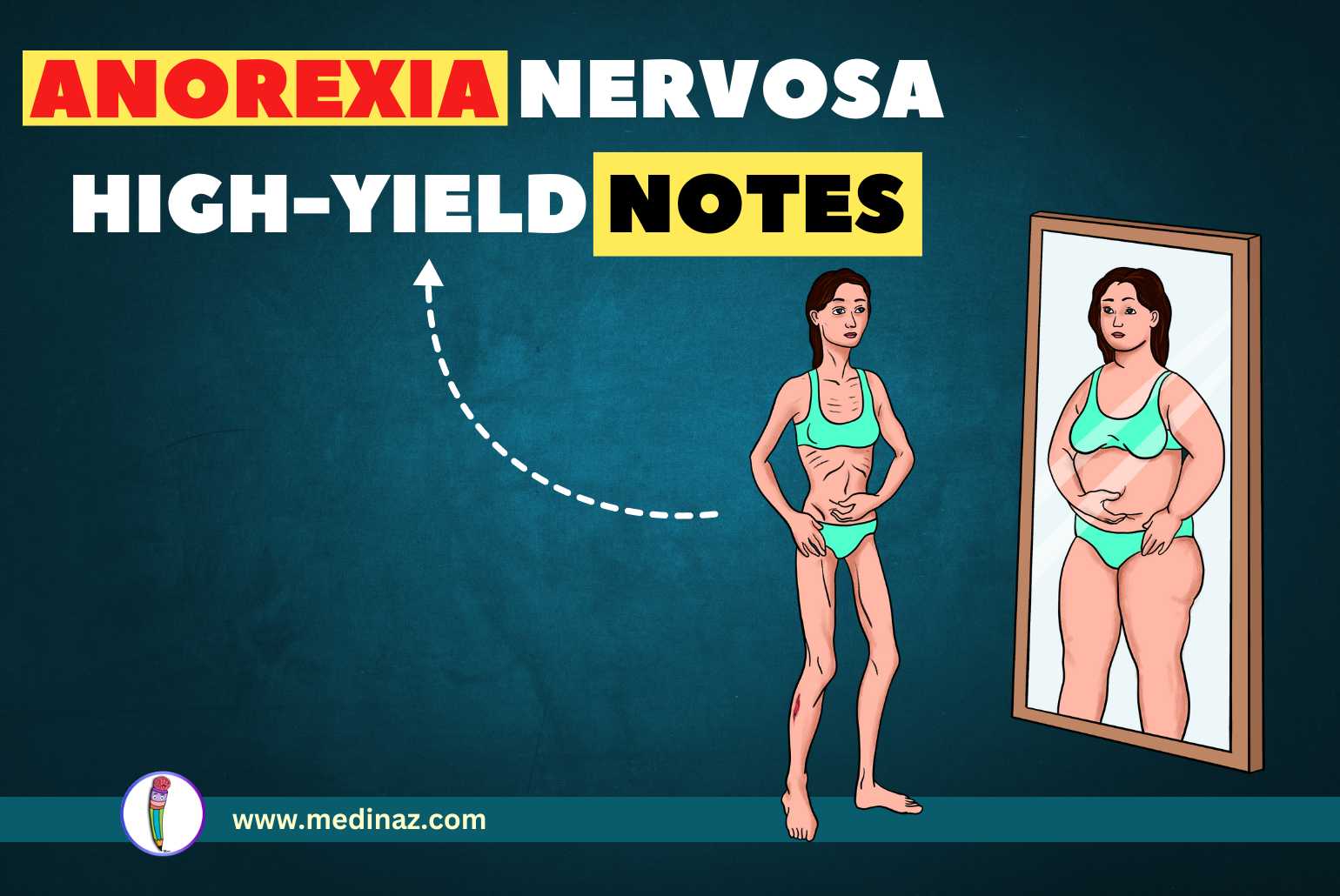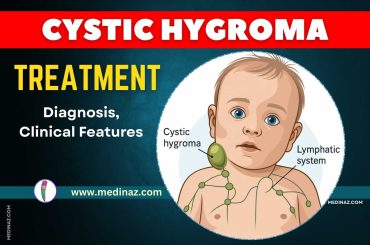Anorexia Nervosa – High-yield Notes for USMLE, NCLEX, NEET PG Exams
Overview
- Definition: Anorexia nervosa is an eating disorder characterized by an intense fear of gaining weight, a distorted body image, and severe restriction of food intake, leading to significantly low body weight.
- Etiology: Multifactorial, involving genetic, psychological, and sociocultural factors.
- Epidemiology: More common in females, typically onset in adolescence.
Pathophysiology
- Psychological Factors: Perfectionism, obsessive-compulsive traits, and a strong desire for control.
- Biological Factors: Genetic predisposition, abnormalities in neurotransmitter systems (e.g., serotonin).
- Sociocultural Factors: Societal emphasis on thinness and body image.
Clinical Features
- Behavioral Symptoms:
- Restrictive eating patterns
- Excessive exercise
- Preoccupation with food, dieting, and body image
- Physical Signs:
- Significant weight loss (BMI < 18.5)
- Amenorrhea (absence of menstruation)
- Bradycardia (slow heart rate)
- Hypotension (low blood pressure)
- Hypothermia (low body temperature)
- Lanugo (fine, downy hair on the body)
- Dry skin and brittle hair
- Peripheral edema
- Osteoporosis

Subtypes
- Restricting Type: Weight loss is achieved through dieting, fasting, and/or excessive exercise.
- Binge-Eating/Purging Type: Recurrent episodes of binge eating or purging behavior (e.g., self-induced vomiting, misuse of laxatives, diuretics).
Risk Factors
- Genetic predisposition
- Family history of eating disorders
- Psychiatric comorbidities: Depression, anxiety disorders, obsessive-compulsive disorder (OCD)
- Sociocultural factors: Pressure to conform to societal ideals of beauty and thinness
Diagnosis
- DSM-5 Criteria:
- Restriction of energy intake relative to requirements, leading to significantly low body weight.
- Intense fear of gaining weight or becoming fat, even though underweight.
- Disturbance in the way one’s body weight or shape is experienced, undue influence of body weight or shape on self-evaluation, or persistent lack of recognition of the seriousness of the current low body weight.
- Laboratory Tests:
- Electrolyte panel: Hypokalemia, hyponatremia
- CBC: Anemia, leukopenia
- Thyroid function tests: Low T3 and T4
- Bone density scan: Osteopenia or osteoporosis
- Psychological Assessment: Evaluate for comorbid psychiatric conditions.
Treatment
- Nutritional Rehabilitation:
- Gradual weight restoration through a structured meal plan.
- Monitoring for refeeding syndrome (electrolyte imbalance and fluid shifts).
- Psychotherapy:
- Cognitive-behavioral therapy (CBT): First-line treatment; focuses on altering dysfunctional thoughts and behaviors related to eating and body image.
- Family-based therapy (FBT): Particularly effective for adolescents.
- Pharmacotherapy:
- Limited role; SSRIs (e.g., fluoxetine) may be used for comorbid depression or anxiety.
- Medical Monitoring:
- Regular monitoring of weight, vital signs, and electrolytes.
- Hospitalization in severe cases (e.g., BMI < 15, hemodynamic instability, severe electrolyte imbalance).
Complications
- Cardiovascular:
- Arrhythmias
- Heart failure
- Mitral valve prolapse
- Endocrine:
- Amenorrhea
- Osteoporosis
- Hypoglycemia
- Gastrointestinal:
- Gastroparesis
- Constipation
- Renal:
- Renal failure
- Psychiatric:
- Depression
- Anxiety
- Suicide
Prognosis
- Outcome: Variable; early intervention improves prognosis.
- Factors Affecting Prognosis: Severity of illness, duration of untreated illness, presence of comorbid conditions, family support.
Prevention
- Education and Awareness: Promoting healthy body image and eating habits.
- Early Detection: Screening for eating disorders in at-risk populations.
Mnemonics
- ANOREXIA for features of Anorexia Nervosa:
- Amenorrhea
- Nutritional deficiency
- Obsessive behavior
- Restricted diet
- Emaciation
- Xtreme weight loss
- Image distortion
- Anxiety about weight gain
Chart: Diagnostic Approach to Anorexia Nervosa
| Step | Diagnostic Tool | Purpose |
|---|---|---|
| 1 | Clinical Examination | Identify physical signs and symptoms |
| 2 | DSM-5 Criteria | Confirm diagnosis |
| 3 | Laboratory Tests | Detect electrolyte imbalances, organ damage |
| 4 | Psychological Assessment | Evaluate comorbid psychiatric conditions |
| 5 | Bone Density Scan | Assess for osteopenia or osteoporosis |
Table: Treatment Modalities for Anorexia Nervosa
| Treatment Modality | Example(s) | Remarks |
|---|---|---|
| Nutritional Rehabilitation | Structured meal plan | Prevents refeeding syndrome |
| Psychotherapy | Cognitive-Behavioral Therapy (CBT), Family-Based Therapy (FBT) | First-line treatment |
| Pharmacotherapy | Fluoxetine (SSRI) | Limited role; for comorbid conditions |
| Medical Monitoring | Regular weight and electrolyte checks | Monitor for complications |
Key Points
- Early intervention with nutritional rehabilitation and psychotherapy is crucial.
- CBT and FBT are the most effective psychotherapeutic approaches.
- Monitoring for refeeding syndrome is essential during nutritional rehabilitation.
- Electrolyte imbalances and cardiovascular complications are common and require careful monitoring.
eck other important USMLE Notes
A Visual Learning Platform





